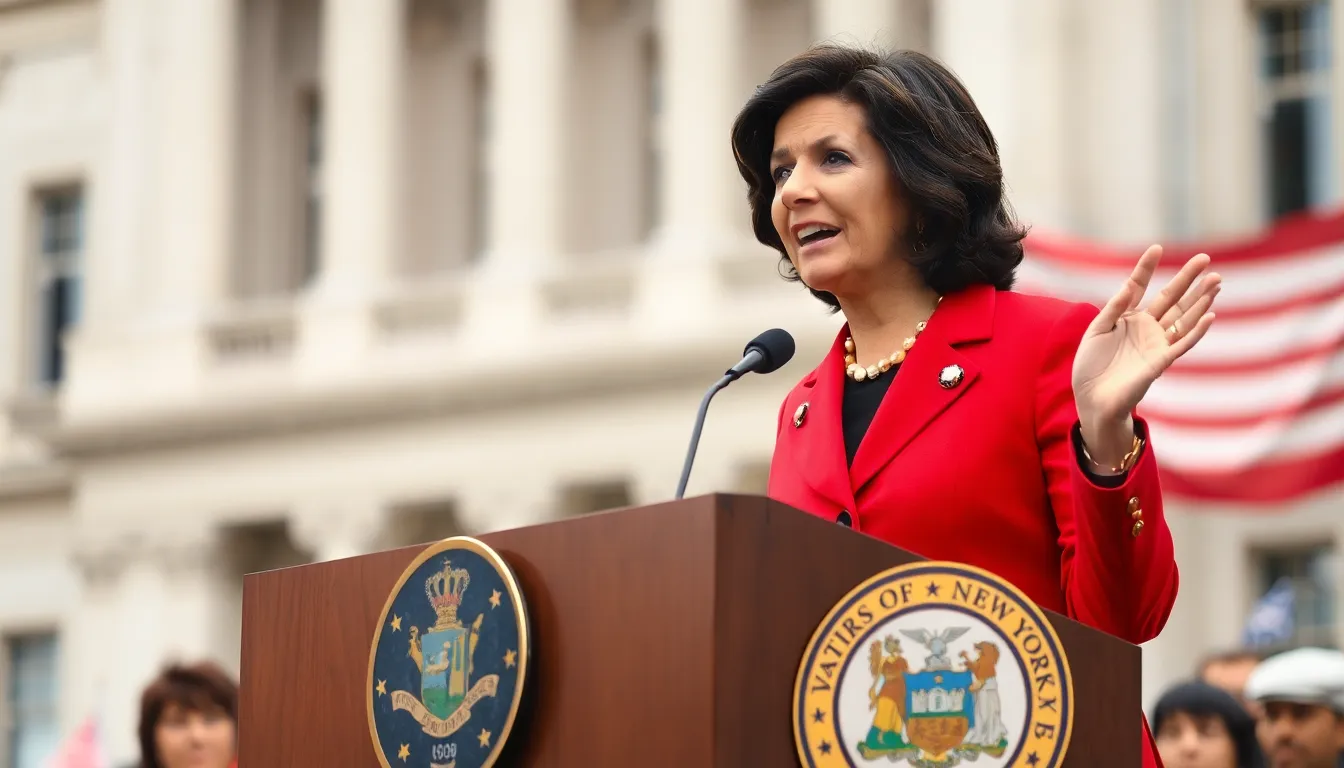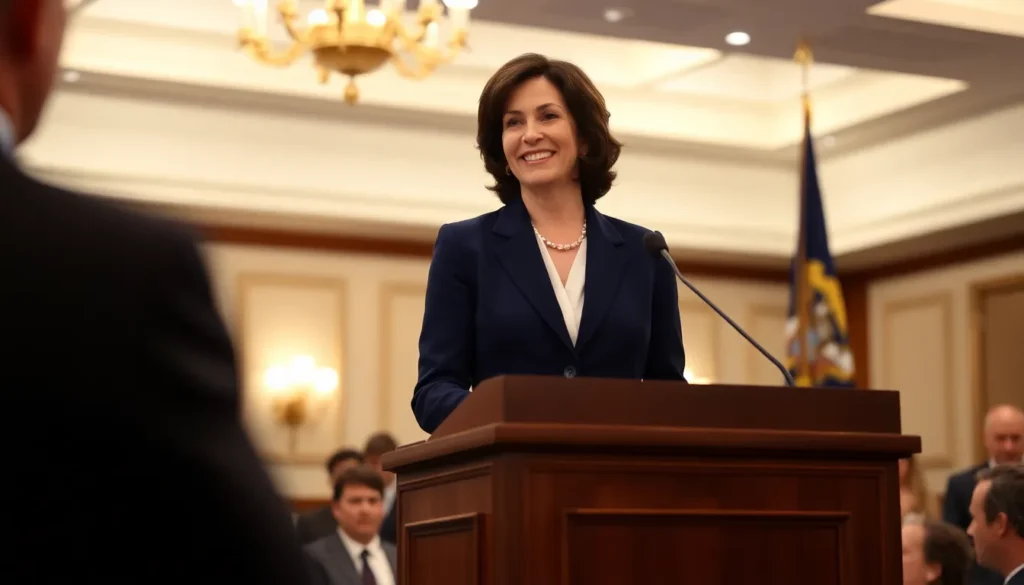Kathy Hochul is the name on everyone’s lips in New York politics, and for good reason. As the first female governor of the Empire State, she’s breaking glass ceilings while juggling the complexities of leadership like a pro. Hochul’s journey from Buffalo to the governor’s mansion is nothing short of inspiring, proving that sometimes the path to power is paved with a little grit and a lot of determination.
Table of Contents
ToggleOverview of Kathy Hochul
Kathy Hochul serves as the first female governor of New York, marking a historic moment in the state’s political landscape. She commenced her political career in local government, representing Buffalo in various capacities, including as a member of Congress. Rising through the ranks, Hochul became the lieutenant governor in 2015, gaining valuable experience and insight into state governance.
Her leadership style emphasizes collaboration and transparency. Hochul’s administration prioritizes critical issues like public safety, economic recovery, and healthcare reform. Engaging with various stakeholders, she fosters dialogue to address the needs of New Yorkers effectively.
As governor, Hochul has implemented policies focused on boosting economic opportunities. Job creation initiatives and support for small businesses remain central to her agenda. Additionally, she champions environmental sustainability, advocating for clean energy investments across the state.
A notable aspect of Hochul’s leadership is her commitment to social justice. She actively supports initiatives that address inequalities, particularly in healthcare and education. Under her guidance, New York has seen progress in expanding access to resources for marginalized communities.
Kathy Hochul’s governance reflects a blend of her experiences and values, creating a unique approach to leadership. Her ascent to the governorship showcases her resilience and dedication, inspiring many across the nation. The future of New York will continue to evolve under her stewardship, laying a foundation for innovative policies that benefit all citizens.
Political Background

Kathy Hochul’s political journey reflects a deep commitment to public service and community engagement. She has demonstrated resilience and leadership from her early career to her current role as governor.
Early Career
In her early career, Hochul worked as an attorney and served as a local government advocate. She gained experience within the Western New York community, emphasizing her commitment to public work. Serving as a legislative aide, she supported initiatives that focused on economic development and public safety. Her focus on local issues honed her understanding of constituents’ needs. Hochul’s work with the Erie County Legislature further reinforced her dedication to improving the lives of New Yorkers.
Entry into Politics
Hochul’s entry into politics began with her successful campaign for the Hamburg Town Board in 2007. Her passion for public service resonated with voters, showcasing her effectiveness as a candidate. Following this role, she earned a seat in the U.S. House of Representatives in 2011, representing New York’s 26th congressional district. While in Congress, Hochul championed various initiatives, including women’s rights and economic reform. Her legislative experience laid a solid foundation for future leadership roles, enabling her to influence state policy and governance effectively.
Role in the Democratic Party
Kathy Hochul plays a vital role in the Democratic Party, reinforcing its values and driving initiatives that resonate with constituents.
Support for Democratic Values
Hochul advocates for fundamental democratic values such as equality, healthcare access, and economic opportunity. Her policies reflect a commitment to social justice, particularly in education and healthcare. She champions women’s rights and actively promotes legislation that aims to reduce disparities. Despite challenges, Hochul remains focused on building a fairer society. Her emphasis on transparency also fosters trust within the party and among voters. Effective communication remains a hallmark of her leadership style, encouraging a more inclusive political climate.
Key Alliances and Endorsements
Hochul’s alliances significantly enhance her influence within the Democratic Party. Key endorsements from prominent figures and organizations bolster her leadership. She has gained support from unions, progressive groups, and fellow elected officials. These relationships strengthen her platform and amplify her message on critical issues. Collaborating with various stakeholders allows her to address diverse needs across New York. Her ability to unite various factions within the party demonstrates her commitment to collective progress. Building coalitions remains essential to her strategy for advancing Democratic priorities in state governance.
Major Achievements as Governor
Kathy Hochul has made significant strides as governor of New York, focusing on legislation and crisis management.
Legislative Accomplishments
Hochul passed key laws that expanded abortion rights and strengthened gun control measures. These legislative achievements reflect her commitment to women’s rights and public safety. She secured funding for education and healthcare improvements, prioritizing vulnerable communities across the state. Hochul also championed policies aimed at combating climate change, such as renewable energy initiatives and emissions reductions. Her ability to build bipartisan support helped advance many of these initiatives, ensuring their successful implementation. Each of these accomplishments demonstrates her dedication to progressive governance and responding to constituents’ needs.
Response to Crises
Hochul’s crisis management style showcased her leadership during the COVID-19 pandemic. Immediately after taking office, she prioritized vaccination efforts and established access to testing resources. Addressing public safety concerns, she initiated measures to combat rising gun violence and promote community policing. Hochul implemented strategies to support mental health resources, acknowledging the pandemic’s impact on New Yorkers. Additionally, she responded decisively to natural disasters, coordinating state resources for recovery and rebuilding efforts. Each challenge reinforced her reputation as a responsive and proactive leader.
Challenges Faced
Kathy Hochul encounters various challenges in her role as governor of New York. Opposition from political rivals and controversies surrounding her decisions impact her leadership and agenda.
Opposition and Controversies
Criticism often arises from Hochul’s actions and policies. Some Democrats express concern over her centrist approach, fearing it dilutes party values. Additionally, high-profile controversies, such as responses to the COVID-19 pandemic, created divisions among constituents. Enacting policies aimed at economic recovery and public safety sometimes results in pushback from both the left and right. Navigating these opposing viewpoints requires her to balance numerous stakeholder interests effectively. Public discussions around gun control measures and abortion rights illustrate the complexities of her leadership.
Public Perception
Public perception of Hochul fluctuates based on her policies and responsiveness to pressing issues. Many constituents appreciate her focus on social justice and economic opportunity. Trust in her leadership often bolsters support within the Democratic Party. Recent polling indicates a divided opinion, with some voters acknowledging her proactive governance during crises while others challenge her commitment to progressive ideals. Engagement with community members plays a crucial role in shaping her image. Constantly addressing constituents’ needs strengthens her connection to voters.
Future Prospects
Kathy Hochul’s future in politics hinges on her continued ability to connect with constituents and navigate complex issues. As she tackles concerns like public safety and economic recovery, her approach will shape voter perception significantly. A focus on initiatives that enhance healthcare access and social justice stands out, appealing to many in her base.
Recent polling data shows fluctuating public opinion, requiring Hochul to adapt her strategies. Expanding her engagement efforts with community members can strengthen her image and enhance her relations with constituents. Tackling divisive topics, such as gun control and abortion rights, will demand a careful balance between party loyalty and personal convictions.
Leadership through collaboration remains a cornerstone of Hochul’s strategy, allowing her to build consensus with various stakeholders. Communities appreciate her transparency and commitment to progressive governance. Additionally, her ability to foster alliances with unions and advocacy groups will prove crucial in advancing Democratic priorities.
Facing challenges from political rivals complicates her roadmap to sustained influence. Adapting her messaging to address concerns from both centrists and progressives bolsters her position within the Democratic Party. Long-term success depends on her capacity to bridge divides and unite diverse factions under a shared vision for New York.
Leveraging her background in local and state governance can effectively inform her decision-making process. Prioritizing issues that resonate with voters, such as economic opportunities and environmental sustainability, enhances her political capital. Ultimately, Hochul’s future prospects will largely depend on how well she navigates the complexities of leadership and maintains her commitment to her constituents.
Kathy Hochul’s journey as New York’s first female governor exemplifies her commitment to progressive governance and social justice. Her ability to navigate complex political landscapes while addressing critical issues like economic recovery and public safety showcases her leadership strengths. As she faces challenges from political rivals and fluctuating public opinion, her focus on collaboration and transparency will be essential in uniting diverse factions.
Hochul’s dedication to advocating for healthcare access, environmental sustainability, and economic opportunity is vital for her continued influence within the Democratic Party. By prioritizing constituents’ needs and fostering community engagement, she has the potential to solidify her legacy as a transformative leader in New York’s political landscape. Her future will depend on her capacity to adapt and connect with voters while championing the values that resonate most deeply with them.









